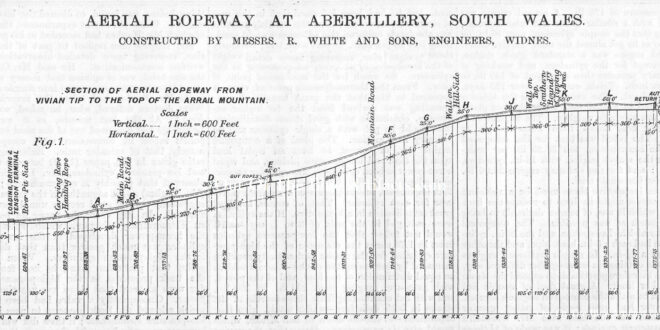The Vivian Colliery Aerial Ropeway Flight.
In 1909 the Powell’s Tillery Company erected the flight from the Vivian Colliery up to the summit of the Arael Mountain. It was constructed by Messrs R. White & Sons, engineers of Widnes. It was completed, tested and opened in June 1909. It was built to take the waste from the colliery up to the top of the mountain at a slight angle from the colliery grounds close to the gas tanks, spanning the Aberbeeg Road over a protective bridge close to the Abertillery Rubbish Destructor. (Its route can be seen in the map image on another page).
The Installation of the Ropeway.
The ropeway was built on their sectional system. In this system the carrying rope was divided up into a number of sections so that comparatively light ropes could be used, even old colliery winding ropes or haulage ropes could have been used for the shorter lengths. In the case of the longer span over the river close to Upper Arrail Street, a special “locked coil rope” was used, this was a larger 2″ inch diameter rope.
The Details of the Ropeway.
The rise from the pithead to the summit was 800 feet, the average gradient was 1 in 5, though in places it was as much as 1 in 2. The waste was transported in buckets which were designed to carry 8 cwt each but in practise they would often exceed 12 cwt per load. The buckets were dispatched at a rate of two per minute giving an approximate carrying capacity of 60 tons per hour.
It was intended to operate the ropeway only at daytime, this was desirable to keep the wages down and for a proper watch on its workings for safety reasons. A large hopper was constructed by the engine house for the storage of waste through the night and its transport next day. The hopper had five filling chutes controlled by valves for easy filling into the buckets. The engine which was 100hp was situated by the filling station and hopper drove the ropeway through a friction clutch arranged so that in case of an accident the rope could be immediately stopped without having to wait for the engine to stop.
The drive took place through bevel gears, and one of the wheels was fitted with a ratchet and two pawls, making it impossible for the line to reverse in case of a power cut. There were twelve standards each at a height of 50′ feet. The tipping spread was 130′ feet in diameter at the base of the release standard. The line was worked by only four men, an engine driver, one man checking incoming and out-going buckets, one filling the buckets and the fourth man keeping a check on the lines and operation at the top of the mountain.
The Later years.
In May 1920 a serious landslip on the Arael Mountain close to the Abertillery Gas Works resulted in the collapse of the protective bridge. Mr S. A. Bennett the county surveyor published notices of the closure of the Aberbeeg Road to motor traffic and warned pedestrians to be aware of walking under the flight when the buckets are in motion.
In the mid 1920’s the council approached the colliery company to utilise the flight for the disposal of the waste from the Abertillery Rubbish Destructor, this was at a time when the by-products built up at the site and became hard to sell on to the building trade.
I am not sure when the tipping of waste on the mountain from the Vivian Colliery ceased.
The waste tip from the Vivian Colliery at the top of the Arael Mountain was removed and the coal in it recycled along with coal newly mined by opencast mining in a project started in the mid 2000’s. The site has recently been landscaped and returned to its natural state.
 Out Of The Blue Artifacts A Library of a lifetime of collecting
Out Of The Blue Artifacts A Library of a lifetime of collecting
